Norway Cruise Report & Planning Guide
If you’re planning to set sail on the Disney Magic for one of its Norwegian Fjords or Norway itineraries, this guide offers some tips and info to make the most of your Disney Cruise Line trip! In it, we will offer general tips for cruising through Norway and share suggestions for some of the ports of call included on Disney’s Norwegian cruises.
Basically, this post serves as an alternative to reading our 7-Night Norwegian Fjords Disney Cruise Report, with all of the planning information from those posts pulled out and presented here. If you’ve already read that, skip this–it’s over 90% redundant. If you have a surplus of spare time, you can read the full report via the links below:
- Day 1: Transportation Woes & Coppenhagen Arrival
- Day 2: Day at Sea
- Day 3: Stavanger
- Day 4: Ã…lesund
- Day 5: Geiranger/Impromptu Day at Sea
- Day 6: Bergen
- Day 7: Day at Sea
Note that our 7-Night Norwegian Fjords cruise itinerary will likely differ from future years. For instance, I know that next year, Disney Cruise Line is going to Oslo, Norway and one of them is even overnighting in Iceland (color me jealous!). So, while some port info might be inapplicable, general tips and info about taking a cruise to Norway should remain instructive.
General Tips for Norway
The first thing you should know about Norway is that it’s an incredibly expensive place to visit. Of the places we’ve visited, Norway is right up there with Switzerland as the most expensive. Everything from fast food to transportation to fuel and even alcohol costs significantly more money in Norway. Even a meal at a place like McDonald’s will give you some sticker shock in Norway.
This is something we realized while initially planning a non-Disney Cruise Line visit to Norway. Originally, our plan was to go in late November or early December, with the aim of seeing Scandinavia’s wonderful Christmas markets, the countries blanketed in snow, and perhaps even the Northern Lights. We found airfare from Los Angeles to Oslo that was absurdly low (~$250) that time of year, and also saw low prices on hotels (since it’s the off-season; during the summer, hotels are just as expensive as everything else).
After finding the airfare deal, I had done a ton of research into the Norway in a Nutshell tour, and also how to incorporate Stockholm and Copenhagen into our itinerary. We had held off booking that trip, primarily due to some hesitations about the amount of daylight, cold weather, and other potential schedule conflicts. Then, we stumbled upon a deal on Disney Cruise Line’s Norwegian Fjords itinerary that we couldn’t pass up.
A big selling point with the cruise was the included transportation, food, and (floating) hotel. Although Disney Cruise Line commands premium pricing, when comparing the costs of the entire DCL itinerary to what we’d pay to do it ourselves in Norway, it actually worked to our advantage to do the cruise. This is a definite selling point for Disney’s Norway itineraries, from our perspective.
We did quite a bit of research for this trip, reading a ton of blog posts and checking out several books from the library (the best ones were Rick Steves Snapshot Norway and Eyewitness Guides Norway). Learning a few Norwegian pleasantries can be useful and polite, but most Norwegians know at least a functional amount of English.
We’d highly recommend consulting those books for generalized background about Norway (Rick Steves also has a few episodes of his PBS show that we’d recommend watching), but the amount of generalized planning you’ll need to do for Norway is limited. Transportation, dining, and hotels are all non-factors when taking a cruise.
A couple of things that we do think are important pertain to packing. First, you’ll absolutely want a pair of water-resistant or (ideally) waterproof shoes. We both packed our hiking shoes, and we’d recommend doing something similar even if you don’t plan on hiking. Norway is a very wet country, and just walking around the cities can be unpleasant without waterproof gear (it rained for about 60-70% of our trip).
We’d also highly recommend packing an array of layers. You’ll definitely need a waterproof & windproof outer layer, an insulating layer (think a down jacket), and a moisture-wicking base layer. We’d recommend packing multiple moisture-wicking shirts, as well as socks. These items are essential for a cruise like this.
My recommendation for the outer layer is something GORE-TEX. It can be very expensive, but it’s made to last, and most brands that use GORE-TEX have generous repair policies. (I had my last GORE-TEX jacket for ~10 years and sent it in to have holes repaired twice…before I was finally “advised” that it looked “very 1990s.”)
In terms of general planning for Norway, that’s about all we have to offer if you’re doing a cruise. Now, let’s turn to port-by-port planning…
Port Tips: Stavanger
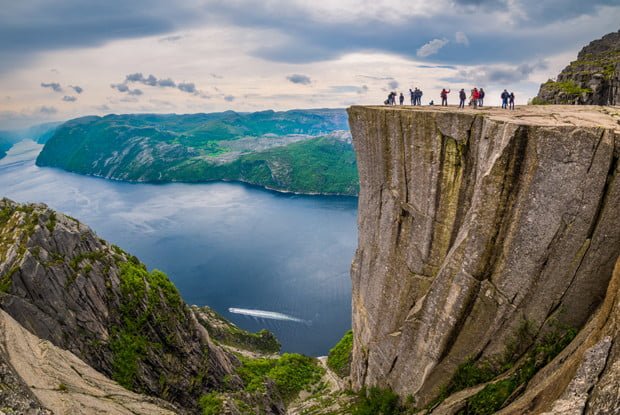 Stavanger is a fascinating city because it has a rich history with commercial fishing, but has transformed in the last ~50 years to become Europe’s oil and energy capital.
Stavanger is a fascinating city because it has a rich history with commercial fishing, but has transformed in the last ~50 years to become Europe’s oil and energy capital.
In 1969, the first Norwegian oil field was discovered at Ekofisk south in the North Sea, which made the Stavanger region a key player in the Norwegian economy. The oil industry in the region has made locals and Norway quite wealthy in the process (Norway’s wealth management and fiscal policies are themselves fascinating, albeit beyond the scope of this report).
Today, Stavanger seems to be a blend of old and new, with a small town university feel and also features modern and old world charm.
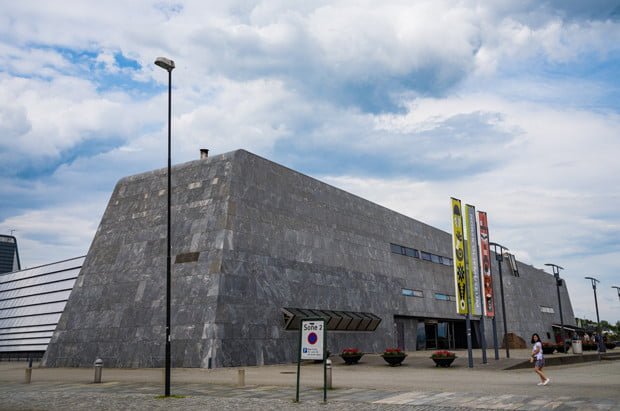 As with many of these port cities in Norway, Stavanger has a compact layout and is easily walkable. For the majority of things you might want to do in port, there’s no need to rent a car, use a taxi, or rely on the various forms of public transportation. There is one notable exception to this, which we’ll cover below.
As with many of these port cities in Norway, Stavanger has a compact layout and is easily walkable. For the majority of things you might want to do in port, there’s no need to rent a car, use a taxi, or rely on the various forms of public transportation. There is one notable exception to this, which we’ll cover below.
My top things were the Norwegian Petroleum Museum (yes, really–it sounds really fascinating!), Norwegian Canning Museum, Old Stavanger, and hike to Preikestolen (Pulpit Rock).
Based upon my research, we could do both museums and Old Stavanger, or Pulpit Rock and nothing else. While the museums sound fascinating, Pulpit Rock was the clear winner for me.
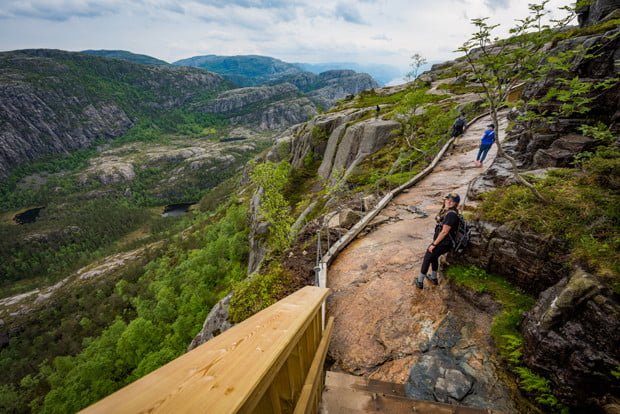 Disney Cruise Line offers a Port Adventure for hiking to Pulpit Rock, but the goal of the Norwegian Fjords cruise for us was to save money over what a non-cruise trip to Norway would cost, so that was out.
Disney Cruise Line offers a Port Adventure for hiking to Pulpit Rock, but the goal of the Norwegian Fjords cruise for us was to save money over what a non-cruise trip to Norway would cost, so that was out.
Instead, I did some research and found what appeared to be a relatively easy way to do this hike on your own via public transit. That’s what we ended up doing, and if you’re visiting Stavanger on a future cruise, I’d highly recommend it.
Hiking to Pulpit Rock is a moderately intense, 4.4-mile hike with an elevation gain of ~1,000 feet. Despite Disney Cruise Line requiring guests be 12 years or older, the hike is appropriate for people of all ages who are physically fit to a reasonable degree. You will need hiking shoes, and I’d also recommend athletic attire and a hydration pack.
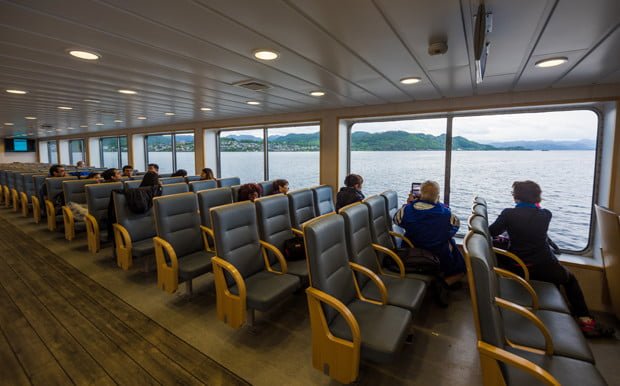 As far as strategy for getting from the cruise port to the trailhead, we’d recommend purchasing a Tide Ferry & Bus ticket and doing it yourself. With that ticket in hand, be ready to get off the ship 15 minutes before the official ashore time and run to the ferry, which is about 12-15 minutes away.
As far as strategy for getting from the cruise port to the trailhead, we’d recommend purchasing a Tide Ferry & Bus ticket and doing it yourself. With that ticket in hand, be ready to get off the ship 15 minutes before the official ashore time and run to the ferry, which is about 12-15 minutes away.
From the ferry, Tide has buses that are synchronized, so it’s a simple matter of stepping off the ferry and lining up for the bus. All told, the ferry and bus take around 70 minutes to get you to the Pulpit Rock trailhead. From there, the hike is roughly 4 to 4.5 hours roundtrip (about the same amount of time up as down, albeit less intense down), plus however long you want to spend up at Pulpit Rock.
Due to the above time constraints and transportation schedules, it’s advised that you begin the descent from Pulpit Rock by 12:30 p.m. in order to make the last bus. Tide is one of two bus services operating at the trailhead–if you’re tight on time, you may have to purchase a ticket for the other bus. No big deal.
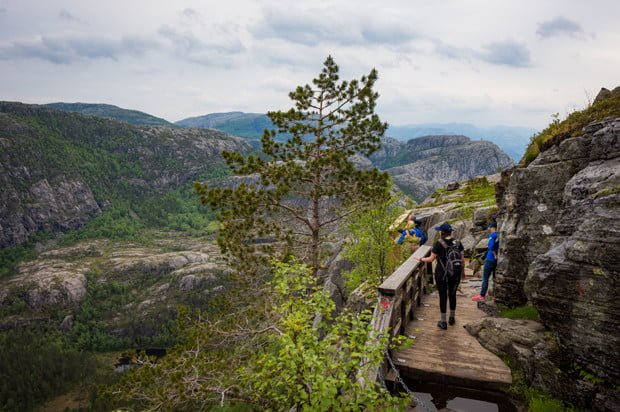 While we encountered many people on the cruise who fretted about having to turn around before making it to Pulpit Rock, or worried about worst case scenarios involving paying for a taxi from the trailhead to the cruise port.
While we encountered many people on the cruise who fretted about having to turn around before making it to Pulpit Rock, or worried about worst case scenarios involving paying for a taxi from the trailhead to the cruise port.
These hypotheticals are unlikely. You should have an adequate window to make it up there whether you’re on the first or second ferry, so long as you’re in reasonably good shape.
Ultimately, I would highly recommend the hike to Pulpit Rock to anyone visiting Stavanger, Norway. I love to hike, and have done some incredible hikes in the Canadian Rockies, Yosemite National Park, Swiss Alps, and many other locations. I would put the hike to Pulpit Rock among the top 5 hikes I have ever done.
Pulpit Rock was stunning. The view from the top was breathtaking, with a panorama of mountains ahead and Lysefjord snaking past the mountain plateau. It was one of the most beautiful views I’ve ever witnessed, and it’s easy to see why this is such a popular hike.
The hike back down was not nearly as pleasant as the hike up. If you’re hiking alone and are relatively sure-footed, this wouldn’t be such a problem because you could pretty easily bounce around, but that’s not simple when you’re with a group. If you had an empty trail, I could see a fit individual making it down in a little over an hour.
Actually, although I indicated the hike would take ~4 hours above, that was a conservative estimate. If you’re in good shape and it’s a dry day, I could easily see making the hike in 3 hours flat. Add in the transportation, and it could be a bit of a tight day, but we had ample time to do a few other things after we arrived back in Stavanger.
 After the return bus & ferry ride, we arrived back in Stavanger shortly after 3 p.m., which was slightly later than I expected when planning this out. We briefly debated going to the Norwegian Petroleum Museum and just trying to do that as quickly as possible, but decided that’d be a waste of money and we’d have to rush through.
After the return bus & ferry ride, we arrived back in Stavanger shortly after 3 p.m., which was slightly later than I expected when planning this out. We briefly debated going to the Norwegian Petroleum Museum and just trying to do that as quickly as possible, but decided that’d be a waste of money and we’d have to rush through.
Instead, we wandered through the city, before stopping at the Norrøna store, which was about 5 minutes from the ship. After that, we headed to Godt Brød Bakery nearby (also about 5 minutes from port) to get some school bread…
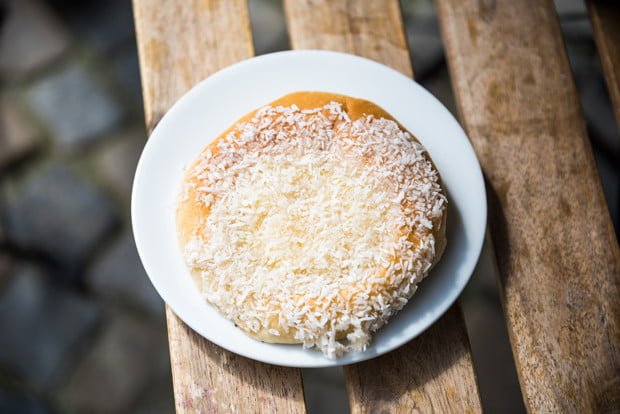 This was our first time having school bread outside of the Norway pavilion in Epcot, and it was fantastic. This is a Norwegian chain, and one that you’ll also find in other ports. This school bread was next-level quality, and we revisited it at future port stops.
This was our first time having school bread outside of the Norway pavilion in Epcot, and it was fantastic. This is a Norwegian chain, and one that you’ll also find in other ports. This school bread was next-level quality, and we revisited it at future port stops.
Port Tips: Ã…lesund
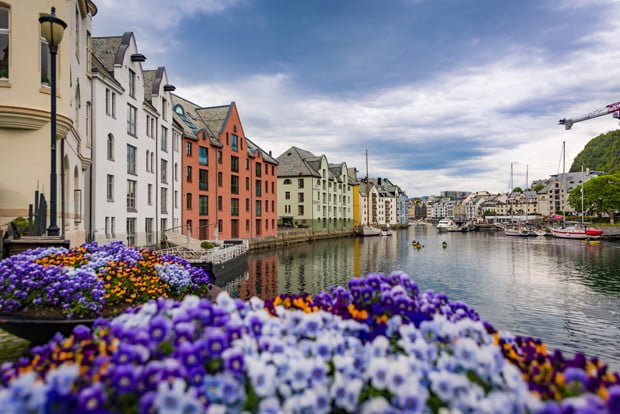 Ã…lesund was simply explore the city. This city has a fascinating history…thanks to the entire town burning down in January 1904. The stated cause is supposedly a cow kicking over a torch–between this cow and Mrs. O’Leary’s, cows are quite the pyromaniacs.
Ã…lesund was simply explore the city. This city has a fascinating history…thanks to the entire town burning down in January 1904. The stated cause is supposedly a cow kicking over a torch–between this cow and Mrs. O’Leary’s, cows are quite the pyromaniacs.
Following the fire, German Kaiser Wilhelm II sent emergency assistance, and dozens of out-of-work architects descended upon the city. Art Nouveau was the international flavor of the time, and the vast majority of the city was rebuilt in a Norwegian flavor of Art Nouveau. Ã…lesund now stands as something of a case study in the style, with it dominating much of the city-center.
Aside from just wandering around taking in this unique city (and also visiting the Art Nouveau Centre (Jugendstilsenteret) to learn more about it), we had a few goals for this port. First, Sunnmøre Museum. This is an open air museum with 55 old houses allowing visitors to step back in time as it showcases bygone culture and building styles. Oh, and it also has viking ships.
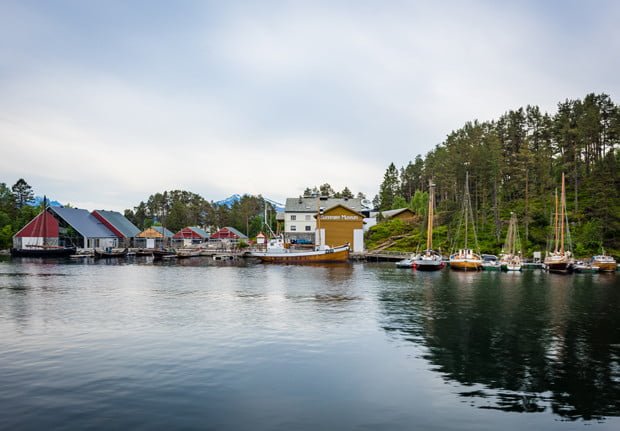 My desire to visit Sunnmøre Museum was motivated mostly by the potential photo ops, but it sounded like the substance would be worthwhile, too. One thing to note is that Sunnmøre Museum is where Disney Cruise Line’s pricey Frozen meet & greet excursion takes place, causing the entire place to close to guests who are not participating in that.
My desire to visit Sunnmøre Museum was motivated mostly by the potential photo ops, but it sounded like the substance would be worthwhile, too. One thing to note is that Sunnmøre Museum is where Disney Cruise Line’s pricey Frozen meet & greet excursion takes place, causing the entire place to close to guests who are not participating in that.
Second, Aksla Viewpoint. Also going by the name Fjellstua Viewpoint, this is the #1 thing to do in Ã…lesund per TripAdvisor reviews. It’s easy to see why, as the photos I had seen from this location were stunning…and it’s free!
To accomplish the first and second items, we debated purchasing a City SightSeeing Hop-on Hop-off bus ticket. This company operates in most (all?) of the port cities, and we never ended up using them. We were dissuaded by some tepid reviews complaining of too few buses, but ultimately we learned that these are all very walkable cities. I’m glad we didn’t buy tickets for this bus, but your mileage may vary on that.
Third, the Majestic Island of Glorious Puffins. Officially known as Runde Island, I had read about the experience of taking a RIB Wildlife Sea Safari out to see these little birds. Doing a RIB (rugged inflatable boat) tour was on our list of things to do in Norway, but this ultimately did not make the cut for Ã…lesund due to a combination of cost (over $100), time, and alternatives.
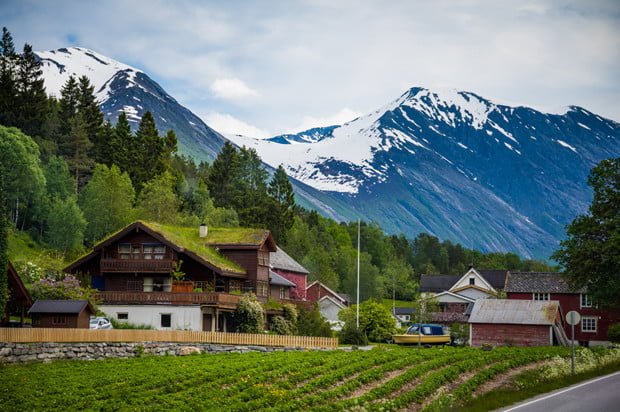 Finally, the Path of Trolls or Trollstigen. This is basically a winding mountain drive with numerous hairpin turns that takes visitors through the Trolltindene mountain range and through Reinheimen National Park.
Finally, the Path of Trolls or Trollstigen. This is basically a winding mountain drive with numerous hairpin turns that takes visitors through the Trolltindene mountain range and through Reinheimen National Park.
A ‘mountain drive’ might not sound particularly appealing, but there’s a good chance you’ve unknowingly seen photos of this–it’s breathtaking.
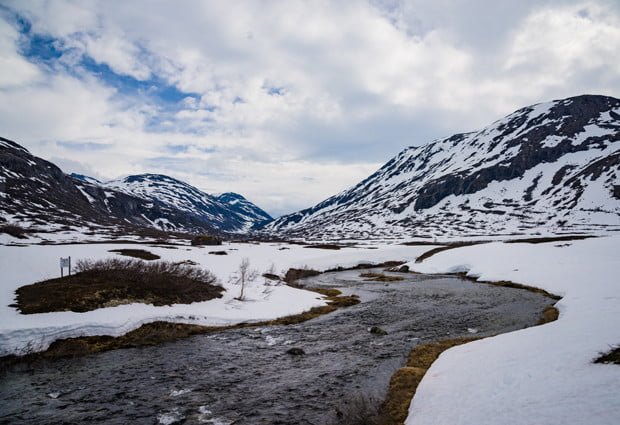 I had seen such photos, and as soon as I realized what Path of Trolls was, it became my #1 choice for Ã…lesund. Unfortunately, it’s not actually in Ã…lesund, and doing it would basically consume our entire day. That was not the only problem, either.
I had seen such photos, and as soon as I realized what Path of Trolls was, it became my #1 choice for Ã…lesund. Unfortunately, it’s not actually in Ã…lesund, and doing it would basically consume our entire day. That was not the only problem, either.
I tried to rent a car in Ã…lesund so we could do the Path of Trolls ourselves. Not only would it be cheaper, but we could do it more efficiently and not have to wait for a group. Unfortunately, the Avis rental car agency in Ã…lesund was sold out by the time we booked the cruise.
Instead, we did the Disney Port Adventure, which we’d highly recommend. We’re both incredibly glad that we did the Path of Trolls. The tour was pretty efficient and our guide was knowledgeable and had a subtly wry sense of humor that was engaging.
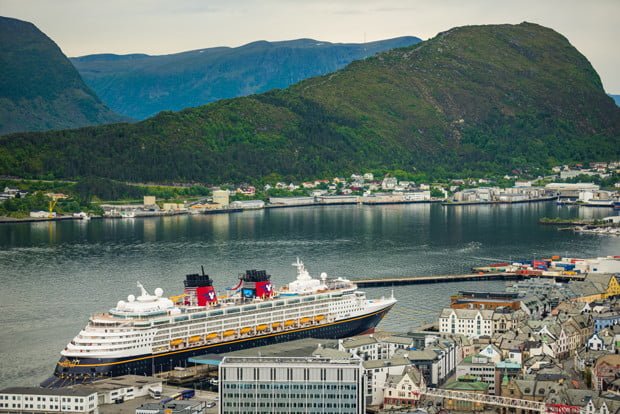 If you have the option, I’d recommend booking the Path of Trolls Port Adventure via Disney Cruise Line rather than renting a car and driving yourself, unless you’re really comfortable behind the wheel and/or have a family and want to avoid paying ~$165 x4.
If you have the option, I’d recommend booking the Path of Trolls Port Adventure via Disney Cruise Line rather than renting a car and driving yourself, unless you’re really comfortable behind the wheel and/or have a family and want to avoid paying ~$165 x4.
I’d avoid the version with lunch, but if you have no option, having lunch provided is not the end of the world. The buffet was surprisingly good, and–so long as you like salmon–you get decent value by Norwegian standards.
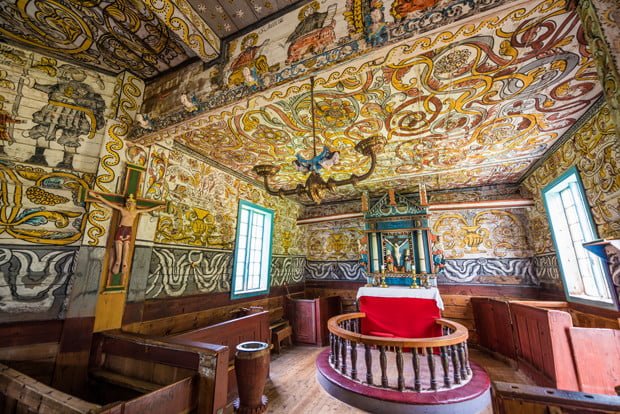 The drive began with a stop at Stordal Church, which gave us time to explore on our own for 15-minutes. This church was beautiful, with a tapestry of fresco paintings covering the interior. It may be an odd way to describe it, but this art felt almost like a tattoo sleeve.
The drive began with a stop at Stordal Church, which gave us time to explore on our own for 15-minutes. This church was beautiful, with a tapestry of fresco paintings covering the interior. It may be an odd way to describe it, but this art felt almost like a tattoo sleeve.
The next stop was somewhere in Valldal valley along the waterfront, which was basically a stop for some photos, and a chance to get refreshments at a nearby cafe.
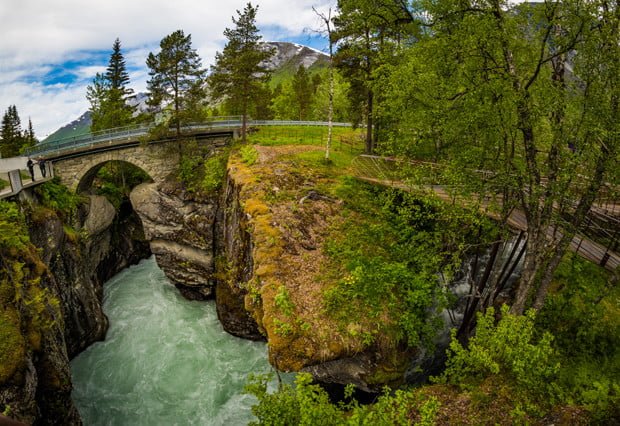 Following that, we headed to Gudbrandsjuvet. This is a narrow gorge through which the Valldøla River runs. Over this area, a beautiful boardwalk and observation platforms have been built.
Following that, we headed to Gudbrandsjuvet. This is a narrow gorge through which the Valldøla River runs. Over this area, a beautiful boardwalk and observation platforms have been built.
After a meandering through Reinheimen National Park, we arrived at what I guess is the “peak” of Trollstigen, a visitor area known as Stigrøra. This area offers a sweeping view down on the “Troll Ladder,” its 11 hairpin bends, and the mountains in the distance.
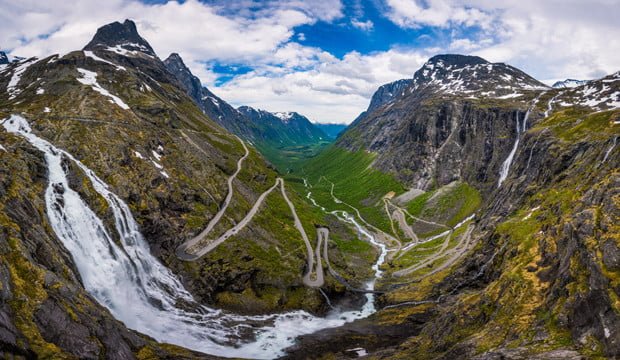 Stigrøra itself is quite beautiful, too. It was designed by Reiulf Ramstad Architects with dramatic lines and organic integration into the rock, soil, and water. I surmise that this was done both for aesthetic reasons and to minimize the buildings’ exposure to brutal winter weather.
Stigrøra itself is quite beautiful, too. It was designed by Reiulf Ramstad Architects with dramatic lines and organic integration into the rock, soil, and water. I surmise that this was done both for aesthetic reasons and to minimize the buildings’ exposure to brutal winter weather.
According to VisitNorway.com, it also houses a restaurant and the Trollstigen Road Museum exhibiting photos, models and hand tools from its construction. Our Stigrøra stop was only 30 minutes, which was a disproportionately low amount of time as compared to other stops and to the quality of this location.
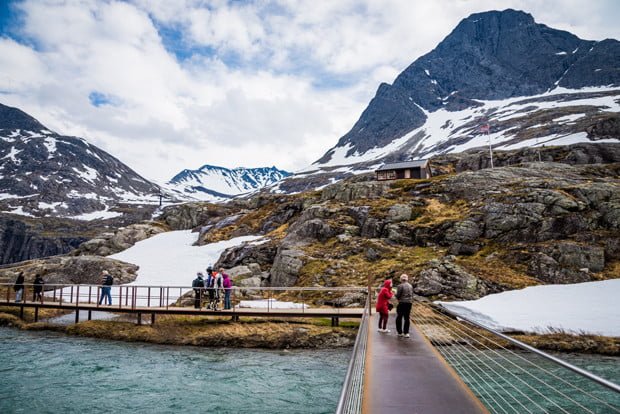 If you do the Path of Trolls, whatever you do, go to the far viewing point.
If you do the Path of Trolls, whatever you do, go to the far viewing point.
The view is unbeatable, and this is the place from where all the “iconic” photos on Pinterest, etc., are shot. This is one of the most dramatic mountain views I’ve ever seen, and is far superior to the lower viewpoint.
After this stop, we began our descent through the 11 hairpin turns of the Path of Trolls (or Troll’s Ladder)…
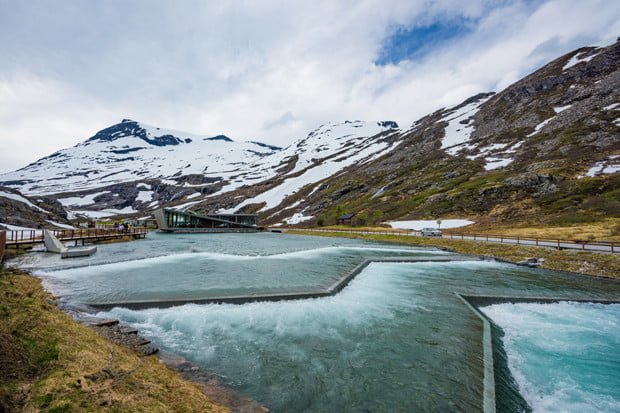 There’s another reason I’m glad we did the Path of Trolls as a Port Adventure, and that’s because I cannot fathom driving that Trollstigen stretch of 11 hairpin turns on our own. It was a nerve-wrecking experience as a passenger. It probably didn’t help that we had a front row seat on the bus, and could see just how close the driver got to the guard rail with each turn.
There’s another reason I’m glad we did the Path of Trolls as a Port Adventure, and that’s because I cannot fathom driving that Trollstigen stretch of 11 hairpin turns on our own. It was a nerve-wrecking experience as a passenger. It probably didn’t help that we had a front row seat on the bus, and could see just how close the driver got to the guard rail with each turn.
Despite those tight turns, the Path of Trolls itself was incredible. I’ve done some of the best drives in the United States, including Going to the Sun Road, the Blue Ridge Parkway, Park Loop Road in Acadia, etc., and none of them compare to this. It was stunning.
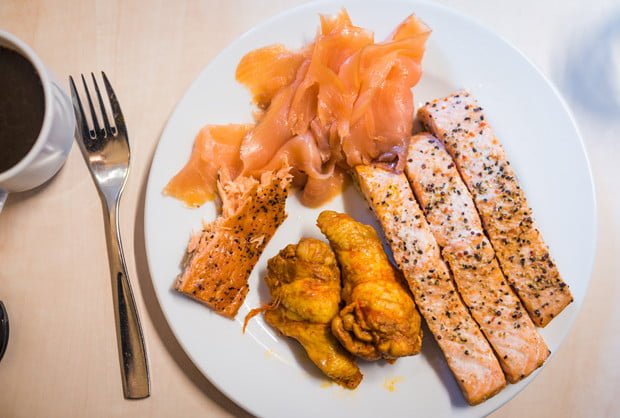 Shortly after finishing the hairpin section of the Path of Trolls, we stopped for lunch at a local restaurant at a place that felt a bit like the Norwegian equivalent of a truck stop shopping center.
Shortly after finishing the hairpin section of the Path of Trolls, we stopped for lunch at a local restaurant at a place that felt a bit like the Norwegian equivalent of a truck stop shopping center.
We continued on, with the next stop being at Troll Wall…
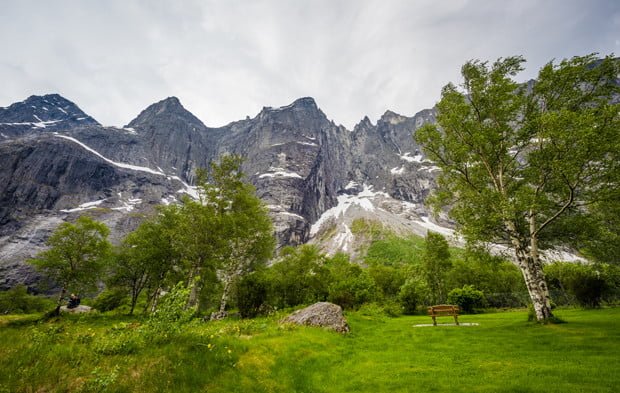 This cool, but not nearly as impressive as Path of Trolls itself. We had 30 minutes here, but we both would’ve been fine with a shorter stop.
This cool, but not nearly as impressive as Path of Trolls itself. We had 30 minutes here, but we both would’ve been fine with a shorter stop.
After that, we began the 2-hour bus ride back to Alesund. It’s a scenic ride back, but after already seeing so much scenery, it might be better-used as some rest time.
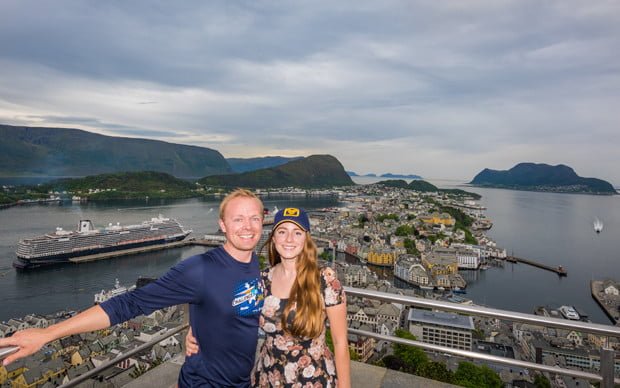 We got back to Ã…lesund with nearly two hours before all aboard (our next port was really close, so we were able to linger until 8:00 p.m. here), so we decided to try doing the Fjellstua Viewpoint.
We got back to Ã…lesund with nearly two hours before all aboard (our next port was really close, so we were able to linger until 8:00 p.m. here), so we decided to try doing the Fjellstua Viewpoint.
We vastly overestimated how long it would take to climb ~400 stairs, but it actually was only like a 10 minute commitment. It looks way worse from the ground. Gorgeous view–I just wish the sky were clear.
After that, we spent the rest of our time in port wandering around the city, mostly looking at the Art Nouveau architecture.
Port Tips: Geiranger
 Unfortunately, we could not stop in Geiranger due to heavy winds, which prevented the Disney Magic from using the floating sea bridge that it normally utilizes in the tiny and cramped port area. From what we understand, this is not entirely uncommon.
Unfortunately, we could not stop in Geiranger due to heavy winds, which prevented the Disney Magic from using the floating sea bridge that it normally utilizes in the tiny and cramped port area. From what we understand, this is not entirely uncommon.
Instead, we’ll share what we intended to do. The main thing to do in Geiranger was get back out on the water to get up close to waterfalls and go into narrower areas of the fjord. In other words, a scenic cruise that passes all of the famous waterfalls, De syv søstrene (“the Seven Sisters”), Friaren (“the Suitor”), and Brudesløret (“the Bridal Veil”).
The two main options, from what we saw, were kayak tours/rentals or RIB tours. We planned upon doing a kayak rental because that looked like the cheapest option, but had not booked this in advance for a couple of reasons.
First, a lot of the reviews indicated the rental companies would just cancel on you if they were able to fill their slots with official excursions booked through the cruise companies. Second, our top (morning) priority was hiking, and we weren’t sure when we’d be done with that.
 The hike we planned on doing was the Storsæterfossen waterfall hike, which takes you past the “backside of water.” If you’re thinking of doing the hike, here’s a detailed report on it. Some other reports indicate this takes you past a cool farm and (potentially) goats, making it a must-do as far as I’m concerned.
The hike we planned on doing was the Storsæterfossen waterfall hike, which takes you past the “backside of water.” If you’re thinking of doing the hike, here’s a detailed report on it. Some other reports indicate this takes you past a cool farm and (potentially) goats, making it a must-do as far as I’m concerned.
There were a handful of museums and other options in Geiranger, but nothing else that really piqued our interest. From our research, the highlight of Geiranger was the fjord, not the quaint village/town. To be perfectly honest, this was probably the port I was least enthused about before the trip.
Port Tips: Bergen
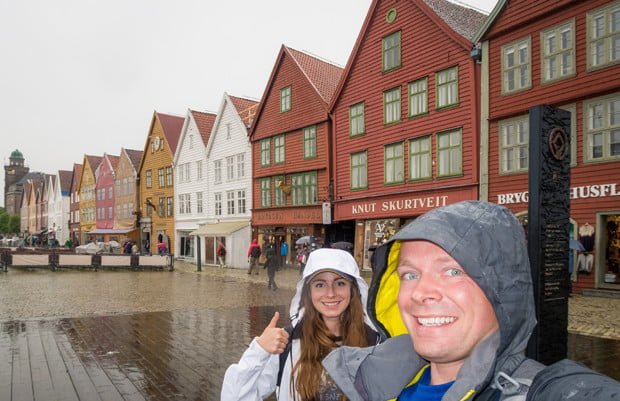 The second-largest city in Norway, Bergen still has a small-town intimacy and atmosphere. These two things work to Bergen’s advantage, giving it plenty of character and points of interest to experience. It’s also a college town, so it has that certain inarticulable energy to it. (Perhaps an odd comparison, but it reminds me a bit of Ann Arbor, Michigan…if that were a Norwegian port city.)
The second-largest city in Norway, Bergen still has a small-town intimacy and atmosphere. These two things work to Bergen’s advantage, giving it plenty of character and points of interest to experience. It’s also a college town, so it has that certain inarticulable energy to it. (Perhaps an odd comparison, but it reminds me a bit of Ann Arbor, Michigan…if that were a Norwegian port city.)
Bergen was the city about which I was most certain when making our itinerary. Even though Bergen has a lot to offer, there was no real conflict or hard decisions that had to be made. I was pretty sure we’d be able to do everything we wanted to do in Bergen.
The first thing to do in Bergen is Mount Floyen and the Funicular. Literally, the first thing. “Rope drop” this; be one of the first people to get off of the ship and walk directly to the funicular.
Alternatively, if you end up sleeping in, you’re likely better off saving it until late afternoon.
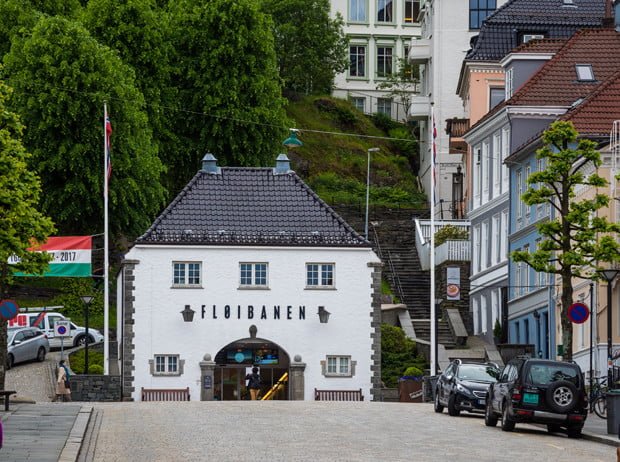 This is a must-do for everyone who visits Bergen, and as such, it seems most cruisers head to the funicular in the morning. We had a zero minute wait to do the funicular, but when we came down, there was a huge line stretching out the door.
This is a must-do for everyone who visits Bergen, and as such, it seems most cruisers head to the funicular in the morning. We had a zero minute wait to do the funicular, but when we came down, there was a huge line stretching out the door.
While up at Mount Floyen, be sure to do the short “hiking” loop that takes you out to the small lake. It’s a lovely, goat-filled trail. We spent around an hour up at Mount Floyen, but you could easily experience it in 30 to 45 minutes. Don’t just go up to see the view and immediately leave.
On your way there, you’ll pass by one of the other must-dos: the Bryggen Hanseatic Wharf. This picturesque series of vibrant, old-world buildings is a UNESCO World Heritage Site, and you’ll want to spend time there later, particularly in the Hanseatic Museum and Schøtstuene.
 We also recommend purchasing the joint ticket for the Hanseatic Museum that also includes the Norwegian Fisheries Museum, and transportation in between.
We also recommend purchasing the joint ticket for the Hanseatic Museum that also includes the Norwegian Fisheries Museum, and transportation in between.
The Norwegian Fisheries Museum is exceptional, and provides a ton of insight into one of Norway’s largest industries. It’s not a huge museum, but features a diverse group of exhibits making it worthwhile for all ages.
Our next recommendation is visiting Old Bergen. This is an under the radar location, and the only reason we went is because a friend told us that part of Spirit of Norway was filmed here. Officially called the Old Bergen Museum, it’s really more of a village than a museum.
It features 50 wooden houses dating from the 18th, 19th, and 20th centuries all reconstructed to form a small town representative of life in Bergen. We walked to Old Bergen from the Norwegian Fisheries Museum, but taking public transit would be more efficient. It’s not a pretty walk.
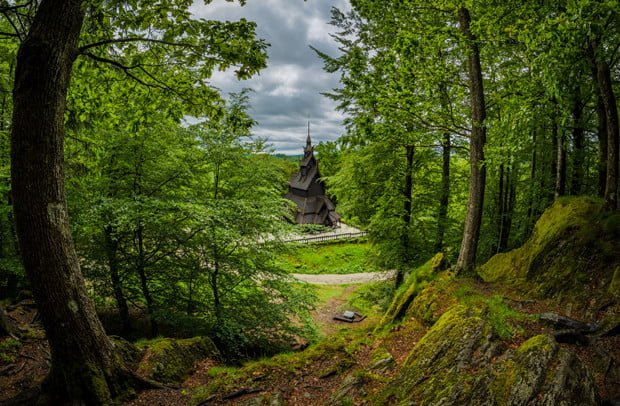 One potential recommendation is Fantoft Stave Church. This is not technically in Bergen, so you have to take the Bergen Light Rail (there’s a station near the Funicular station) out to it. Get off at the Fantoft Station, and it’s about a 10-minute walk from there (signs make it easy to find). Be sure to have cash for admission.
One potential recommendation is Fantoft Stave Church. This is not technically in Bergen, so you have to take the Bergen Light Rail (there’s a station near the Funicular station) out to it. Get off at the Fantoft Station, and it’s about a 10-minute walk from there (signs make it easy to find). Be sure to have cash for admission.
We did this because (to us) a stave church is iconic to Norway due to years of seeing one at Epcot. This one is definitely neat, and in a cool wooded location, but it does take some effort to get there. It was rebuilt in the 1990s, so it doesn’t have the history of some stave churches in Norway, but it’s the only one we could see on the cruise.
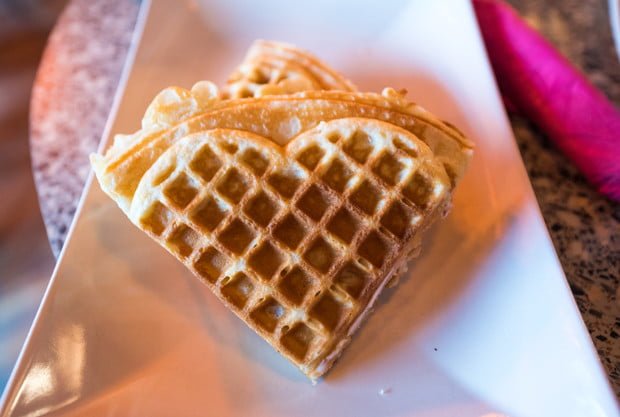 Finally, food. We made an effort to avoid spending money out of pocket at the other ports, but that went out the window in Bergen. On the recommendation of a few friends (and singer Sigrid!), we had pizza at Kafe Special. A good, cheap option that caters to a college crowd, but not distinctly Norwegian.
Finally, food. We made an effort to avoid spending money out of pocket at the other ports, but that went out the window in Bergen. On the recommendation of a few friends (and singer Sigrid!), we had pizza at Kafe Special. A good, cheap option that caters to a college crowd, but not distinctly Norwegian.
We also dined at BarBarista, to try Norwegian waffles. This spot is highly recommended for both its eclectic decor and it’s amazing waffles. Make a point of eating here. Once again, we also stopped at Godt Brød, the bakery where we bought school bread earlier in the trip. We had school bread here again, and it was fantastic.
One thing you might want to consider is the Bergen Card 24 Hours. This provides free or discounted admission to a number of points of interest (including some above), plus unlimited public transit. It didn’t quite work out for us, but if we tweaked our itinerary just a bit, it would have.
We made this recommendation before, but it bears repeating: skip the CitySightseeing Tour Bus. Bergen is easily walkable, and part of the experience is strolling past the storefronts and absorbing the old world charm. The hop-on, hop-off might seem convenient, but really, it’s just a waste of money.
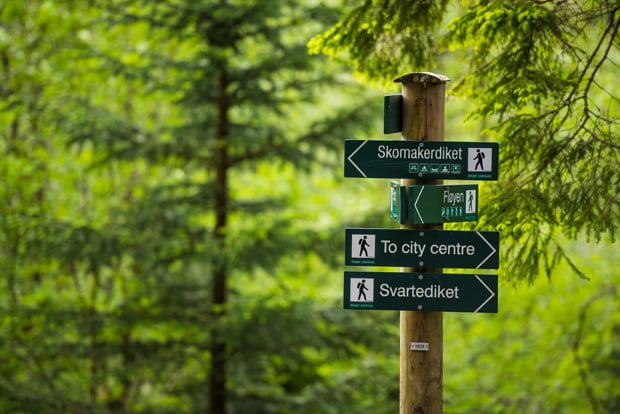 Another option we briefly considered–but quickly ruled out–was a condensed version of the Norway in a Nutshell tour. I’ve mentioned this a few times in the report, so I should probably clarify that this is not an official tour (if you Google it, you might be led to believe otherwise).
Another option we briefly considered–but quickly ruled out–was a condensed version of the Norway in a Nutshell tour. I’ve mentioned this a few times in the report, so I should probably clarify that this is not an official tour (if you Google it, you might be led to believe otherwise).
The Norway in a Nutshell “tour” is a self-guided itinerary consisting of various forms of trains, buses, and ferries that takes you through the mountains and fjords. This is how we were originally planning to see Norway, and when I had planned it out that way, we were expecting to spend around 5 days doing this tour.
The frenetic pace of doing the Norway in a Nutshell tour in a single port day was what caused us to quickly rule this out. Plus, we still hadn’t spent much time just wandering around any of the port cities, and this itinerary would’ve been another port day almost entirely consumed by one activity. By this point in the trip, we were already contemplating a return trip to Norway, and it made more sense to do it then.
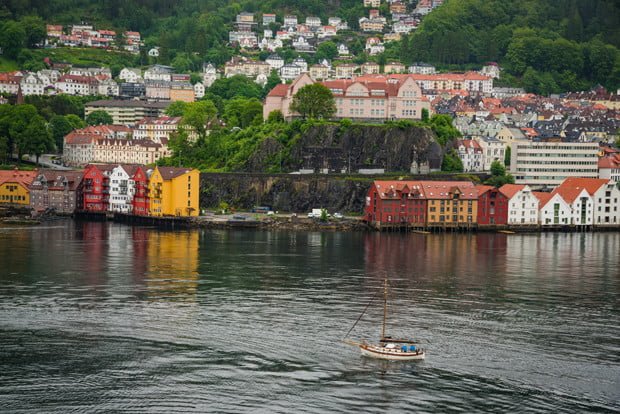 At the time, I thought our itinerary for Bergen was pretty flawless–at least for our interests. In hindsight, I might give some thought to the Bergen City Museum, Bergen Maritime Museum, Fjell Fortress (outside of the city), and KODE — the Art Museums of Bergen. One thing a lot of people also seem to like is the Leprosy Museum, but that does not interest me in the slightest.
At the time, I thought our itinerary for Bergen was pretty flawless–at least for our interests. In hindsight, I might give some thought to the Bergen City Museum, Bergen Maritime Museum, Fjell Fortress (outside of the city), and KODE — the Art Museums of Bergen. One thing a lot of people also seem to like is the Leprosy Museum, but that does not interest me in the slightest.
I’m not even remotely disappointed by our itinerary–we had an excellent day in Bergen. I think it’s more of a hindsight is 20/20 type of thing. I just mention those other locations to provide you with some additional options if you’re planning your own visit. Those tips for Bergen wrap up our Guide to Norway Aboard Disney Cruise Line; as we mentioned at the top of the post, your itinerary might have different ports, but hopefully at least some of this was useful to you, nonetheless!
Planning to set sail aboard one of the Disney Cruise Line ships? Read our comprehensive Disney Cruise Line Guideto prepare for your trip, plan entertainment and other activities, and learn what to expect from your Disney cruise!
If you want personalized recommendations for Disney Cruise Line itineraries, ships, and more, click here to get a cruise quote from a no-fee Authorized Disney Vacation Planner. They can find you all of the current discounts, and help you plan the details of your cruise!
Your Thoughts
Do you agree or disagree with our advice for Norway? Have you done a cruise to Norway…or just visited on your own? Tips to add? Any questions? Hearing feedback about your experiences is both interesting to us and helpful to other readers, so please share your thoughts below in the comments!


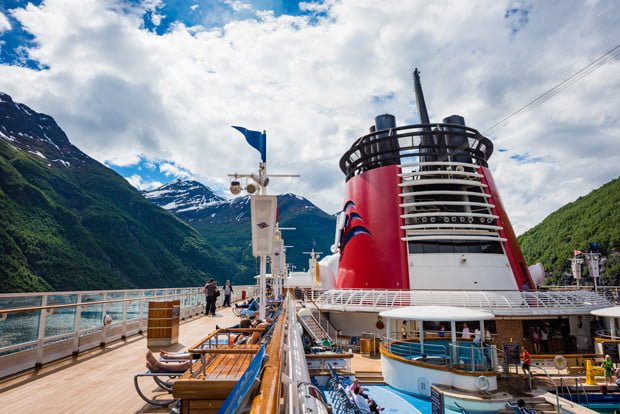
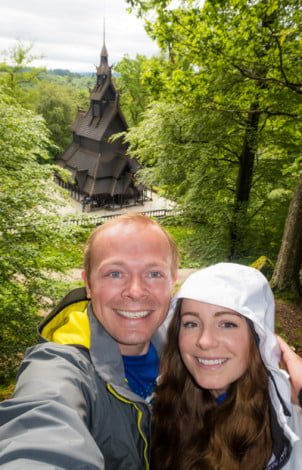
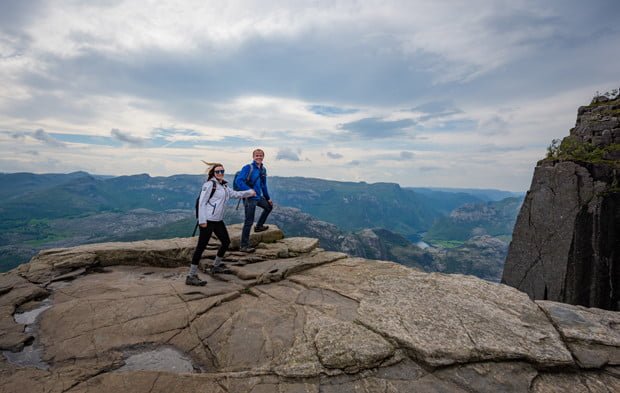
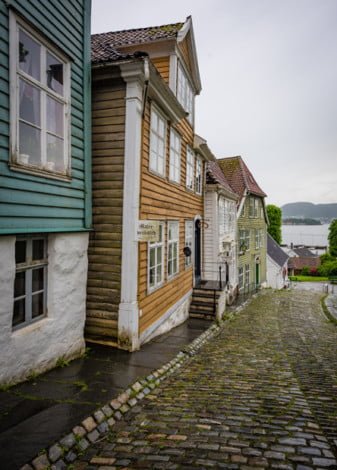
We flew Wow Air in 2015 from Baltimore-Washington (BWI) to London. There were 7 of us (myself, my wife, 3 young boys, and my in-laws). I thought WOW was fantastic. We paid for a carry-on bag for each and because we needed to make sure we sat with our boys we paid to choose our seats. All the employees were very nice. On our return flight we were delayed for a while because of a lightning storm over BWI and the flight attendants handed out complimentary snacks and drinks (normally you pay for everything). You have to factor the entire cost (baggage each way, seats, etc) to decide if it is worth it, but since we had to buy 5 tickets (now 6!) we could not have gone to the UK without WOW. They were the best budget airline I have flown. We just went to California and flew Southwest and I would say the WOW plane was superior (although I like Southwest’s baggage policies better). Hope that helps.
Thank you for this, and Merry Christmas! We are doing the Norway/Iceland/Scotland cruise next summer. We got super cheap flights on WOW ($300 RT pp) to Iceland, then doing connecting flights to Copenhagen / London (which were also pretty cheap). Wondering if you have flown with them?
We have not, and we are slightly weary as the reviews are a bit hit or miss. It looks like if you pack lightly, you can save a lot of money, though!